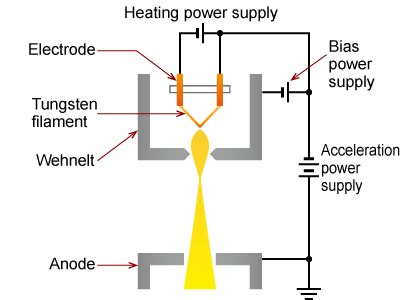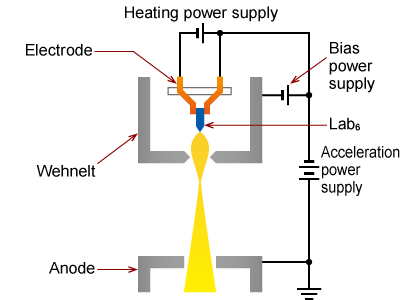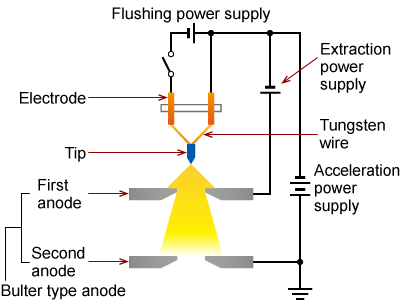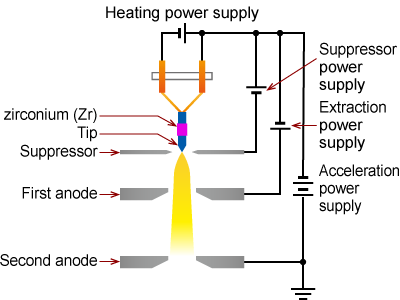
What is a scanning electron microscope?
A scanning electron microscope (SEM) is a microscope that uses an electron beam to obtain magnified images of surfaces that are several tens of times to one million times larger than the original image. Compared to visible light, electron beams have a very short wavelength, making it possible to analyze microscopic irregularities and composition better than with an optical microscope.
Structure of the electron gun
The electron gun is the equivalent of the light source in an optical microscope. Depending on the material of the filament and the method of electron generation, electron beams with different characteristics are generated.
| The tungsten-type thermionic emission gun | Lanthanum hexaboride (Lab6) thermionic emission gun |
|---|---|

|

|
|
Emitter material: Tungsten wire Luminance: 104 - 105 (A / cm2 / sr) Vacuum: 10-3 (Pa) Applications: benchtop SEM to general-purpose SEM |
Emitter material: LaB6 Luminance: 106 (A / cm2 / sr) Vacuum: 10-5 (Pa) Applications: General-purpose SEM |
| Cold Field Emission Gun (Cold FEG) | Schottky Field Emission Gun (Schottky FEG) |
|---|---|

|

|
|
Emitter material: Tungsten single crystal Luminance: 109 (A / cm2 / sr) Vacuum: 10-8 (Pa) Applications: High-resolution SEM |
Emitter material: Zirconia/Tungsten Luminance: 108 (A / cm2 / sr) Vacuum: 10-7 (Pa) Applications: Analytical SEM |
Objective Lens Structure
The objective lens is the most important lens for focusing the image. There are three main types of objective lenses depending on the position of the sample and the shape of the pole piece.
| Out-lens | In-lens | Semi-in-lens |
|---|---|---|

|

|

|
| This is the most common objective lens shape. Place the sample under the objective lens and observe it with the detector. Since the leakage magnetic field is less than that of other objective lenses, it can observe a variety of samples, including magnetic materials. | This objective lens has very low aberration because the sample is placed in the magnetic field of the objective lens. Although it is difficult to observe large samples and magnetic materials, the highest resolution can be achieved by combining it with a field emission electron gun (FE electron gun). | This is an objective lens that is intermediate between the out-lens and in-lens systems. By devising the shape of the pole piece and using a leaky magnetic field, it is possible to observe with a shorter work distance than the out-lens method. |
The difference in how the image looks due to the acceleration voltage
The appearance of the image varies greatly depending on the acceleration voltage. This is because the electron scattering region of the primary electron beam differs depending on the acceleration voltage and the composition, density, and crystal orientation of the sample. The heavier the element and the lower the acceleration voltage, the smaller the electron scattering area and the more sensitive the SEM image. Using a lower acceleration voltage makes it possible to observe the fine texture of light elements, which is not visible at higher acceleration voltages.


The penetration depth of primary electron beam due to the difference in acceleration voltage
1 keV

5 keV

10 keV

Retarding method (deceleration method)
The retarding method is a method in which a negative voltage is applied to the sample to decelerate the primary electron beam just in front of the sample. For example, if the primary electron beam is accelerated to 5.0 kV at the electron gun and -4.0 kV is applied to the sample, the primary electron beam is affected by the negative voltage and is decelerated to an energy of 1.0 kV (= 5.0 kV - 4.0 kV) before being irradiated to the sample. In this method, the primary electron beam passes from the electron source to the objective lens under conditions of high acceleration voltage, which reduces aberrations compared to acceleration to 1.0 kV at the electron gun, and enables high-resolution observation even at low irradiation voltage (low acceleration primary electron beam).


Sample: WS2 powder

Sample: WS2 powder
Major analysis using scanning electron microscopy
When a sample is irradiated with an electron beam, a lot of signal information is generated in addition to secondary electrons and reflected electrons. From there, various analyses can be performed, such as characteristic X-ray analysis (EDS and WDS), backscattered electron diffraction (EBSD), and electron beam induced current (EBIC). This article will discuss energy dispersive X-ray analysis (EDS), which is often used in SEM.
Energy dispersive X-ray analysis (EDS analysis)
When an electron beam is irradiated to a sample, X-rays are generated. An energy-dispersive X-ray spectrometer (EDS) is a device that detects these X-rays and obtains elemental information. In combination with SEM, it is possible to obtain micron-order elemental information.







Related Technical Articles
Related Products
Matsusada Precision manufactures precision high-voltage power supplies for scanning electron microscopes.







